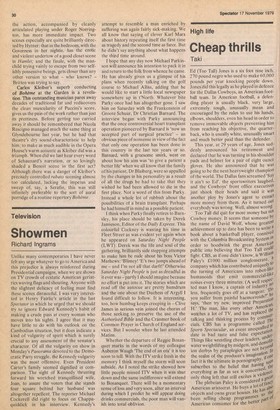Opera
Twin Screws
Rodney Milnes
The Turn of the Screw (Coliseum The Turn of the Screw (Eastbourne) La Scheme (Covent Garden) A new production by the Welsh National earlier this year, Scottish Opera's powerful revival at the Edinburgh Festival, and now two new stagings of Britten's masterpiece within a week: accusations of unnecessary duplication are not appropriate since no two performances, let alone two productions, are ever quite the same. There are striking differences between Jonathan Miller's for the English National Opera and Nicholas Hytner's for Kent Opera, yet both are perfectly valid readings of this horribly unsettling work, and both are extremely well sung.
The style of Miller's is to some extent governed by the size of the Coliseum. One corner of Patrick Robertson's permanent grey-gauze-box set thrusts forward over the orchestra pit and much of the action is played as far down-stage as possible. Behind is the Governess's labyrinth, a forest of black and white projections with a suggestion of long corridors of the mind. The ghosts are anything but other-worldly, stalking the set as corporeally as the living. Their bodies are not in question. In the finale Quint follows Miles on stage and there is a powerful sense of physical battle between governess and ghost for possession of the unfortunate boy. Douglas Heap's set for Eastbourne is a white gauze box, and save for their duologue and Miss Jessel's invasion of the schoolroom, the ghosts keep their distance behind the gauze. The conflict is more in the minds of the living.
At the Coliseum the children are already corrupt, their games incestuous rituals, with Flora played by an adult soprano and very much the dominant partner. It is the world against Miles. In Eastbournc the children are pictures of innocence in the first act, and Flora is well played and sung by a child (Rebecca Platt). Here Miles seems to be the link with the adult, or ghost world. Acted uncomfortably well by Sam Monck, he matures way beyond his years in the second act, an 18-year-old mind in a 13-year-old body. The Coliseum's Miles, Michael Ginn, is a child tout court.
And so on. Eilene Hannan, the Coliseum's Governess, is a sweet, wellintentioned creature trying desperately to act for the best in a situation she canncit begin to understand, her innocence ripe for corruption; Eastbourne's Meryl Drower is twitchier, more of a nagger, more possessive than well-intentioned, and spoiling for a battle. Rosalind Plowright's Miss Jesse! (Coliseum), got up as Janey Morris, relives her earthly fall from grace with her sexuality, once awoken, spectrally, eternally unsatisfied. Elisabeth Anders (Eastbourne) is a more pathetic revenant. The Eastbourne ghosts, float wraith-like in slow motion; those in London are all substance. Without Britten it might be possible to play them sympathetically, but his music for Quint suggests, if not evil, then at least a serious overdose of experience and both Graham Clark (Coliseum) and Neil Jenkins (Eastbourne) are insinuatingly evil of mien. Sadly, both stagings distract attention from the variation interludes, Miller's with a lot of coming and going of extras in the cor ridors, Hytner's with noisy scene changes.
If Hytner's is marginally more satisfying as a production, it is because the very size of the Coliseum diffuses the detail in which Miller works and muddies the incisiveness of Britten's scoring (the playing under Lionel Friend was not faultless), whereas for Kent the action, accompanied by cleanly articulated playing under Roger Norrington, has more immediate impact. Two scenes especially are quite brilliantly directed by Hytner: that in the bedroom, with the Governess in her nightie, has the erotic and violent undertow of a good closet scene in Hamlet; and the finale, with the manchild trying vainly to escape from two selfishly possessive beings, gets closer than any other version to what — who knows? — Britten was trying to say. Carlos Kleiber's superb conducting of BoUme at the Garden is a revelation. This outstanding musician pares away decades of traditional fat and rediscovers the clean muscularity of Puccini's score, gives us the pain of the work rather than just its prettiness. Before getting too carried away it should be remembered that Nicola Rescigno managed much the same thing at Glyridebourne last year, but he had that theatre's dry sound-characteristic to help him; to make as much audible in the Opera House's warm acoustic as Kleiber did was a triumph. When did we last hear every word of Schaunard's narration, or so lovingly shaded a Benoit scene in the first act? Although there was a danger of Kleiber's precisely controlled rubato seeming almost too calculated, lacking the impetus and sweep of, say, a Serafin, this was still infinitely preferable to the sort of aural porridge of a routine repertory Boheme.







































 Previous page
Previous page